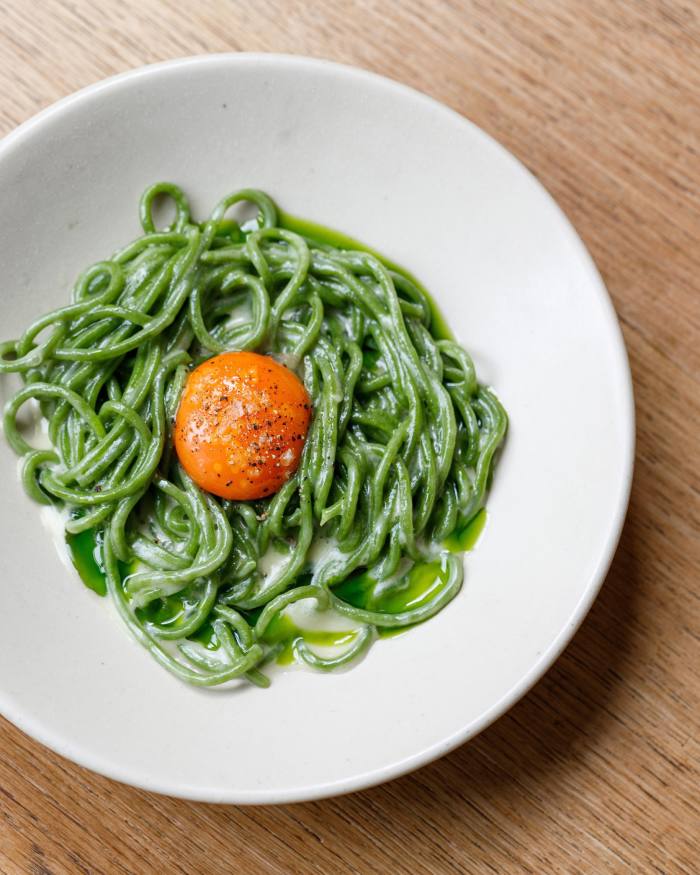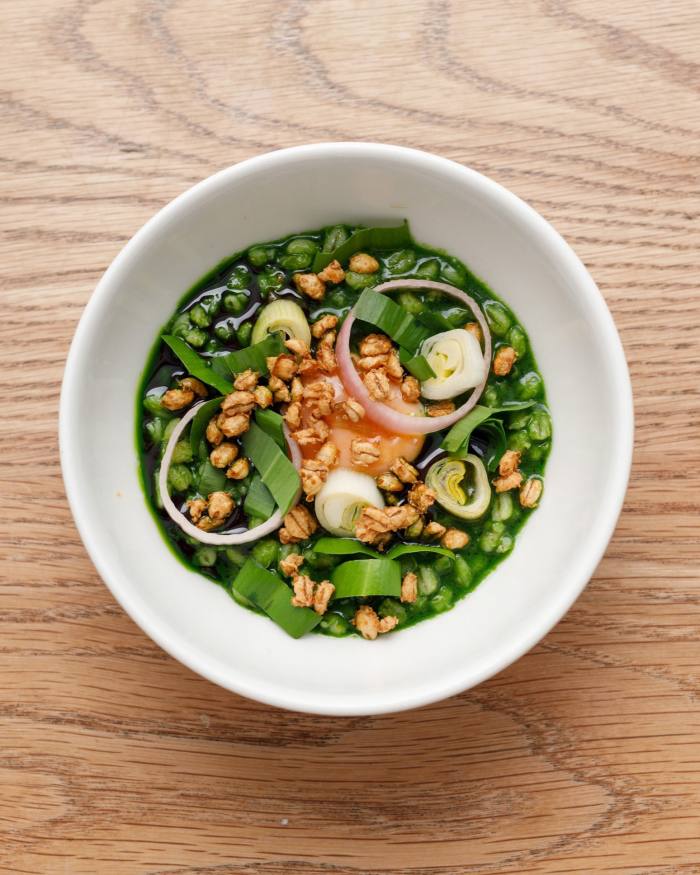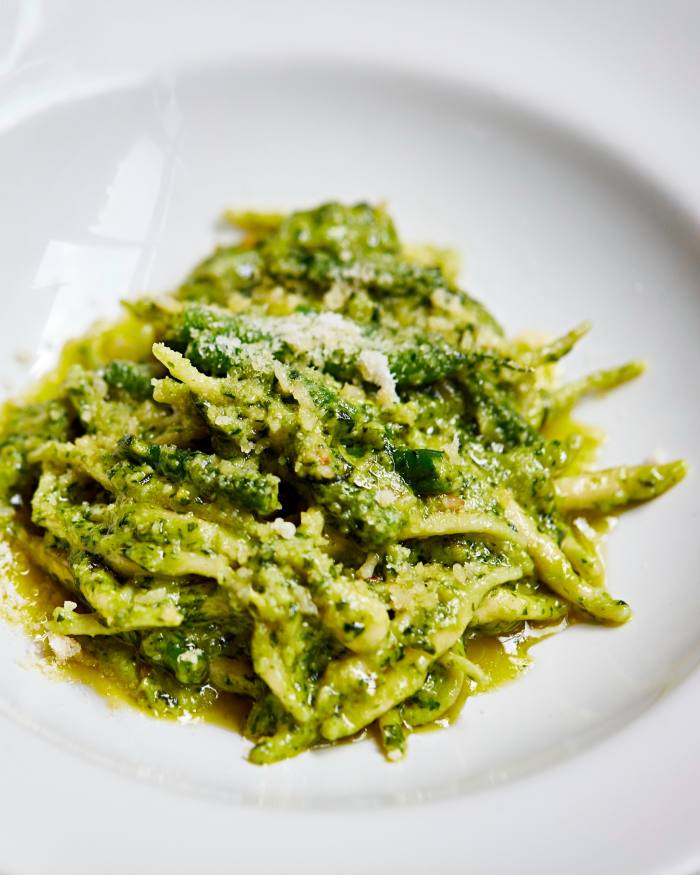This article is part of a guide to London from FT Globetrotter
Name a more joyful ingredient than wild garlic. First harvested in late February, the spear-shaped leaves signify not only culinary delights, but also those of spring. The season is short, reaching its peak at the end of April: once it’s over, you’ve made it to summer.
The growing emphasis on seasonality makes wild garlic, a plant that is native to Britain, a fleeting focus on London’s restaurant circuit, most beautifully expressed in pasta dishes. From simple classics (see Norma’s ravioli stuffed with peas, wild garlic and shallot) to major statements (Jackson Boxer pairs the plant with deep-fried gnocchi, truffle and Tunworth cheese at Orasay), the pliable nature of pasta makes it a perfect vehicle for powerful flavours — and wild garlic’s flavour is just that.


Less pungent than bulb garlic, the wild variety is most similar to the chive member of the allium family, with spinach-like soft leaves that stain your hands when crushed. “When it hits its peak and there’s an abundance of it, the flavour mellows a bit — you can be more frivolous,” says Lasse Petersen, executive chef of Lulu’s (and Llewelyn’s) in south London, where wild garlic is added to both pesto and pasta dough.

Part of the joy of wild garlic is that you can pick it yourself. Every spring, I visit my parents in Somerset, where dense patches grow along the river Frome. It’s tempting to snatch the shoots as soon as they appear, but respectful foragers will wait until the leaves are fully grown. In London, there are whispers that wild garlic grows near Hackney Marshes; a more substantiated claim is that you can find it in Epping Forest, right at the north-east end of the Central Line on the Underground. If you’re lucky enough to come across a clump — you’ll smell it before you see it — be sure to harvest from the middle of the patch and pick it well above the root. Only take what you need, and avoid areas that look depleted. The goal is to preserve the bounty for seasons yet to come.
Once you’ve secured your loot, try making a pesto. To do so, I blend about 100g of wild garlic with a handful of almonds, Parmesan, the juice of a lemon, 100ml of olive oil and two cloves of bulb garlic. Some say it’s better to abstain from the latter: I say, says who? The goal is to unleash as much flavour as possible.

Each of the restaurants featured here has treated wild garlic as a core ingredient, but there are plenty of places to find it murmuring in the background. At Michelin-starred Wild Honey St James, Anthony Demetre serves a wild garlic aioli with his barbecued line-caught mackerel. Similarly, Restaurant St Barts in Smithfield Market uses wild garlic capers — seed heads taken from the plant’s late-blooming flowers that are pickled — to top a Wagyu beef bun. As with any seasonal ingredient, call ahead to avoid disappointment. The only question is how garlicky you can go.
Manteca
49-51 Curtain Road, London EC2A 3PT
In the shadow of a derelict car park, this east London restaurant’s corner location is at first unassuming. Inside, however, is something exceptional. Manteca was opened in 2019 by Chris Leach (ex-Petersham Nurseries) and Smokestak’s David Carter, and its third iteration (the first was on Heddon Street near Piccadilly Circus, the second in Soho) has become one of London’s most in-demand eateries.
The shining stars of the menu come from the on-site salumeria, which serves up a daily-changing plate of coppa, prosciutto cotto, salami and mortadella. This is best consumed with a helping of pillow-soft focaccia, ricotta and a glass of Lambrusco. Then it’s time for pasta.

As with the salumi, Leach and his team hand-make their pasta under the watchful eye of Manteca’s diners from an open kitchen. The cult dish is the brown crab cacio e pepe, but in spring it’s all about the wild garlic chitarra, which arrives dripping in fluorescent-green oil with a perfectly round egg yolk. There is much fun to be had in breaking the yolk, the richness of which can be balanced with, say, a Sauvignon Blanc from Slovakian grower Slobodné. In late summer, preserved wild-garlic capers are used to flavour a lamb ragù, while the plant’s stalks are added to raw beef salads.
Leach also highlights the ingredient both as a star pupil and an accompaniment in his secondi dishes. On a recent visit, slow-cooked lamb shoulder was paired with wood-roasted Roscoff onions and a splash of the aforementioned fluorescent oil. Save a bite of focaccia to help clear up any residue. Website; Directions
Lyle’s
Tea Building, 56 Shoreditch High Street, London E1 6JJ
The emphasis on foraged ingredients at Lyle’s makes wild garlic a key player when in season. Come spring, the menu is a revolving door of allium-infused specials, from suckling kid goat and yoghurt to roast brill and brown butter. Perhaps most special, though, is the ramson and barley porridge, a bowl of shiny green oats topped with ramson capers, egg yolk and a puddle of St Jude cheese sauce. As a standalone dish it’s rich, unctuous and everything a porridge shouldn’t be — which is precisely the kind of porridge I like.

As one of the first Michelin-starred restaurants in Shoreditch, Lyle’s perhaps needs no introduction. Chef-patron James Lowe has remained true to his formula of British-inspired, low-waste dishes that spotlight super-seasonal ingredients. Leftover St Jude cheese will be used in a fruit ice cream in late summer, while the bulk of the ramsons have been foraged by the team themselves. Lowe, who picks his own stock around London and the south-east, recommends a glass of Chablis to counteract the garlicky-ness — but his favourite palate cleanser is a slice of Comice pear. Website; Directions
My Neighbours the Dumplings
178-180 Victoria Park Road, London E9 7HD
At My Neighbours the Dumplings’ outpost in east London’s Victoria Park — its second after the supremely popular Clapton site — wild garlic is stuffed, unsurprisingly, into dumplings. Co-founder Bec Wharton started the restaurant after she and her partner Kris found success rolling their own versions for their friends. Here she offers a sharing menu of dim sum, wontons and potstickers, plus a small range of “hot plates”. (The crispy pork belly is the best I’ve ever had.)
Each spring, Wharton and her family go foraging for wild garlic, which is peppered throughout the menu: last season, in the form of pork bao and sesame noodles, and this year, with crystal steamed dumplings that carry their garlic flavour with white scallop meat and roe. Balancing a dumpling is a careful art at My Neighbours: for every bite of scallop is a crunch of celery; for every whiff of garlic, a hint of dried shrimp. What results is a lighter, more aromatic take on the ingredient — but one with no less of a punch. Vegetarians will enjoy the carrot, black bean and wild garlic spring roll that Wharton advises wrapping in one of the accompanying garlic leaves. A chilli and lime Brussels sprout slaw with pickled goji berries helps to keep things fresh. Website; Directions
Bocca di Lupo
12 Archer Street, London W1D 7BB
As far as Soho institutions go, Bocca di Lupo offers something for everyone. Traditional diners will appreciate the fine-dining feel of the main restaurant and classic dishes such as rabbit saltimbocca (a must). Those looking for something different might sit at the counter, sip on vermouth cocktails and order the softshell crab with radicchio and blood orange.


Wild garlic is a key feature of the spring menu, and tends to linger on the pasta list. My two favourites are the trofie with wild garlic pesto and crunchy green beans, and the pansotti — fat little triangles of wild garlic-stuffed pasta covered in a creamy walnut sauce. One is fresh and signals summer, the other is a comforting reminder of the winter just gone. Later in the season wild garlic will be featured in pappardelle with morels, rabbit orzotto (a dish similar to risotto that’s made with pearl barley instead of rice) and galletto in panzanella (grilled spring chicken with wild garlic, peas, broad beans and baby gem).
A tip: don’t overindulge on the welcome portion of olives and fresh focaccia. Doing so might prevent you from ordering one of the forno e griglia (oven and grill) options, which include langoustines baked in breadcrumbs and grilled potatoes smothered in a potent wild garlic salsa verde. Sensible diners will still have room for an ice cream from Gelupo, the restaurant’s ice-cream parlour across the road. Unfortunately, I’ve never been able to make it there. Website; Directions
Dorian
105-107 Talbot Road, London W11 2AT
As is often the sign of a good restaurant, you’ll smell Dorian before you see it — a tempting waft of grilled meat that stretches down Talbot Road, one of Notting Hill’s less-trodden streets. The smell is the result of an enormous wood-fired grill that takes pride of place in the restaurant’s open kitchen, where sharing steaks sizzle next to gigantic pork chops.

Latest to grace the grill is a whole John Dory, which comes dripping in a wild garlic, butter and chicken-stock sauce. There is more than enough of the pea-green dressing to cover the fish and serve as a dip for crispy pink fir potatoes (and for a second round of bread, if you can manage it). Unusually, the recommended wine pairing is a natural red (Blaufränkisch) from Austrian grower Judith Beck, which makes a change from the more typical white varieties you might expect with fish.
But Dorian is an atypical restaurant. Posited as an “anti-Notting Hill” eatery for those who live in the area, it’s a spot that feels both comforting and ritzy, where couples toast Gillardeau oysters and families pass around generous plates of meat. There is the usual — and delicious — French bistro-style fussiness of crab röstis and truffle-covered liver parfait, but at its heart is feel-good cooking on an impressive fiery grill. Website; Directions
Eline
1C Rosewood Building, Cremer Street, London E2 8GX
Named after co-founder and chef Alex Reynolds’ grandmother, Eline is a breezy, French-inspired restaurant with a focus on seasonal cooking and natural wine. Reynolds’ forte is making complex dishes sound unassuming: a straightforward “charcuterie plate” is actually cured lamb, duck breast and pork and fennel saucisson (all made in house), while the rabbit ballotine is the result of four days of labour. The goal is to make a simple first impression and surprise later on.

For March, Eline presents wild garlic in three ways: in a marinade for a fillet of trout, which is cooked on the barbecue and brushed with wild garlic oil; in a salsa verde for accompanying barbecued small Charlotte potatoes; and in a warm sauce made from buttermilk, crème fraîche, horseradish and three parts wild-garlic oil. Next month, this will swap out for casoncelli pasta stuffed with house-made wild garlic ricotta with an emulsion made from confit fennel and — you guessed it — more wild garlic. But in neither dish is the garlickiness overwhelming; Reynolds’ cooking is all about balance.
No trip to Eline is complete without a snoop around the accompanying wine shop, a selection from which is available in the restaurant by the bottle or glass. Whatever you choose, be sure to finish the meal with a slice of meringue-topped lemon tart. Website; Directions
Any places you’d add — for either eating or foraging for wild garlic? Share them in the comments
Follow FT Globetrotter on Instagram at @FTGlobetrotter




